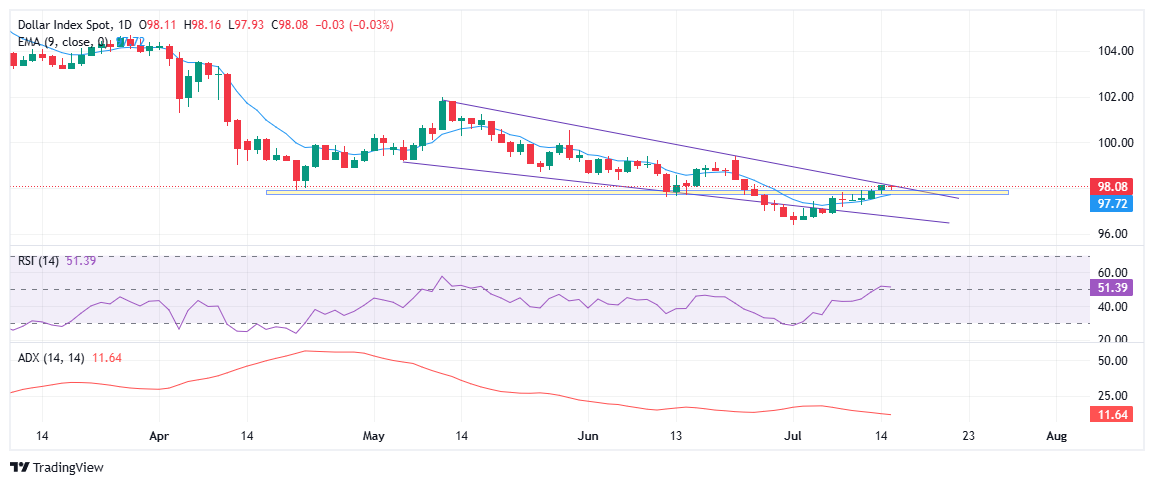- The US dollar lies slightly down before the June CPI data, with the DXY maintaining around level 98.00.
- The feeling of the market remains cautious amid the ongoing tariff threats of US President Trump.
- The June CPI is expected to increase 0.3% compared to last month, while the underlying IPC is projected to rise a 3.0% year -on -year, compared to 2.8% in May.
The US dollar (USD) is quoting in a slightly weaker position on Tuesday while investors prepare for the publication of the US Consumption Price Index (CPI) with market participants relocating before the key inflation data, the dollar is struggling to maintain the profits of the previous day.
The American dollar index (DXY) is modestly quoting down, around the psychological level of 98.00 during the European session. Although the index continues to receive support, it faces a confluence of key technical resistance at current levels, which discourages operators to carry out aggressive bets.
The widest tone of the market remains cautious in the midst of the ongoing tariff threats of US President Donald Trump, while investors expect US CPI data for new directional signals.
The US CPI report is scheduled for publication at 12:30 GMT. The importance of this publication is increased by current economic conditions, particularly concerns about the impact of tariffs on consumer prices. Economists hope that inflation general increases an intermensual 0.3%, which would be the largest monthly gain in five months, after a smaller increase of 0.1% in May. The annual inflation rate is expected to rise to 2.7% from 2.4% in May.
It is projected that the underlying IPC, which excludes food and energy prices, increases 3.0% year -on -year, compared to the advance of 2.8% of the previous month. The expected increase is partly due to the growing costs resulting from the recent US tariffs, which are moving to consumers through higher prices.
Even so, although some of the effects of tariffs may have already been senses, a more substantial influence is anticipated from July. A hottest IPC data could discourage the hopes of short -term interest rate cuts, while a softer reading could rekindle the expectations of a dovish turn by the Fed.
The president of the FED, Jerome Powell, has clearly stated that the uncertainty on the impact of tariffs is one of the main reasons why the Central Bank has avoided cutting interest rates. Powell stressed that the Fed “remained on hold when we saw the size of the tariffs”, and now intends to evaluate how deeply the tariffs will be filtered to consumer prices and growth before softening monetary policy.
While some Fed officials believe that tariffs can cause only a temporal increase in prices, many are concerned that inflationary effects could be more durable, which would make Fed difficult to reduce rates in the short term.
Market movements: Trump reinforces tariffs and criticism of Fed Powell
- On Monday, US President Donald Trump announced plans to impose “very severe tariffs” – potentially up to 100% – Russian exports if a peace agreement is not reached with Ukraine within 50 days. In an additional escalation, Trump also warned about “secondary tariffs” to countries that continue to trade with Russia, particularly pointing to those that still import oil and Russian gas. The movement aims to isolate Moscow economically and increase pressure on its commercial partners, including China, India and Türkiye. These aggressive commercial threats have increased uncertainty in global markets and have raised the fears of more interruptions in global supply chains, particularly in energy sectors and raw materials.
- The 10 -year 10 -year reference treasure bonus performance remained stable above 4.43% on Tuesday, marking a maximum of a month while investors expect the June IPC report today. The sustained increase in yields reflects the continuous expectations that inflation could remain high due to tariff -related pressures, noting that the Federal Reserve could delay interest rate cuts until pricing growth shows lighter cooling signals.
- The Second Quarter Stock season in the US begins this week, with great banks such as JPMorgan, Citigroup and Goldman Sachs scheduled to inform their results. Investors are closely monitoring the impact of cost increase and commercial tensions in companies. Analysts expect a modest profit growth of around 5.8% year -on -year, well below the estimated 10.2% in early April, underlining the impact of uncertainties related to tariffs on corporate benefits.
- The president of the United States, Donald Trump, has once again attacked the president of the FED, Jerome Powell. In comments made on Monday, Trump called Powell “A Cabezón” and criticized him for keeping interest rates too high, arguing that rates should be closer to 1%. He also said that Powell is harming the economy by refusing to act faster in feat cuts. In addition to their criticism of politics, Trump’s comments occur while his administration investigates the recent renewal project of the FED headquarters for 2.5 billion dollars, suggesting that the costs were excessive and insinuating the possibility of fire Powell “for just cause.”
- The Supreme Court has indicated that a president cannot dismiss a Fed president simply for policy disagreements, although misconduct or poor management could be reasons for dismissal. However, the director of the National Economic Council of the White House, Kevin Hasett, has declared that this issue is “being investigated” to determine if it provides a sufficient cause.
- According to The Washington Post, Hasset is emerging as a main candidate to happen to Powell as the next president of the Federal Reserve. Hasset supports the impulse of President Donald Trump for lower rates and runs the risk of being seen by markets as lacking autonomy in politics.
Technical analysis: DXY recovery stagnates, the CPI could boost the next movement

The US dollar index (DXY) is being negotiated near the psychological level of 98.00 while investors expect the publication of the June CPI report.
In the last two weeks, the index has been constantly recovering, supported by the 9 -day mobile average at 97.70. The price is currently testing the upper limit of the triangle about 98.00, but the bullish impulse seems tentative before inflation data. The bulls would need a strong thrust, possibly from a hottest IPC report than expected, to break decisively above 98.00 and strengthen the short -term bullish correction. If that happens, we could see the DXY go to the 98.80-99.00 area in the short term.
Impulse indicators reflect a cautious tone. The relative force index (RSI) remains plane around the neutral level of 50, indicating a strong buying interest.
Meanwhile, the average directional index (ADX) remains weak in 11.64, reflecting a clear lack of tendency.
In general, any great movement depends on the next inflation data. A hottest IPC data could provide the necessary fuel for a bullish rupture above the resistance of the triangle, reinforcing the case to reduce the expectations of interest rate cuts of the Fed and raising the dollar. On the contrary, a softer IPC data could trigger a setback, with immediate downward support seen near the 9 -day EMA in 97.70 and the lower limit of the triangle about 96.50.
Economic indicator
Consumer Price Index (Monthly)
Inflation or deflationary trends are measured by periodically adding the prices of a basket of representative goods and services and presenting the data such as the consumer price index (CPI). IPC data is collected monthly and are published by the Labor Statistics Office of the US the intermensual figure compares the prices of the goods in the month of reference with the previous month. The CPI is a key indicator to measure inflation and changes in consumption trends. Generally, a high reading is considered bullish for the US dollar (USD), while a low reading is considered bassist.
Read more.
Next publication:
Mar Jul 15, 2025 12:30
Frequency:
Monthly
Dear:
0.3%
Previous:
0.1%
Fountain:
US Bureau of Labor Statistics
The US Federal Reserve (FED) has a double mandate to maintain price stability and maximum employment. According to this mandate, inflation should be around 2% year -on -year and has become the weakest pillar of the Central Bank directive since the world suffered a pandemic, which extends until these days. Price pressures continue to increase in the midst of problems in the supply chain and bottlenecks, with the consumer price index (IPC) at maximum levels of several decades. The Fed has already taken measures to tame inflation and it is expected to maintain an aggressive position in the predictable future.
Source: Fx Street
I am Joshua Winder, a senior-level journalist and editor at World Stock Market. I specialize in covering news related to the stock market and economic trends. With more than 8 years of experience in this field, I have become an expert in financial reporting.







